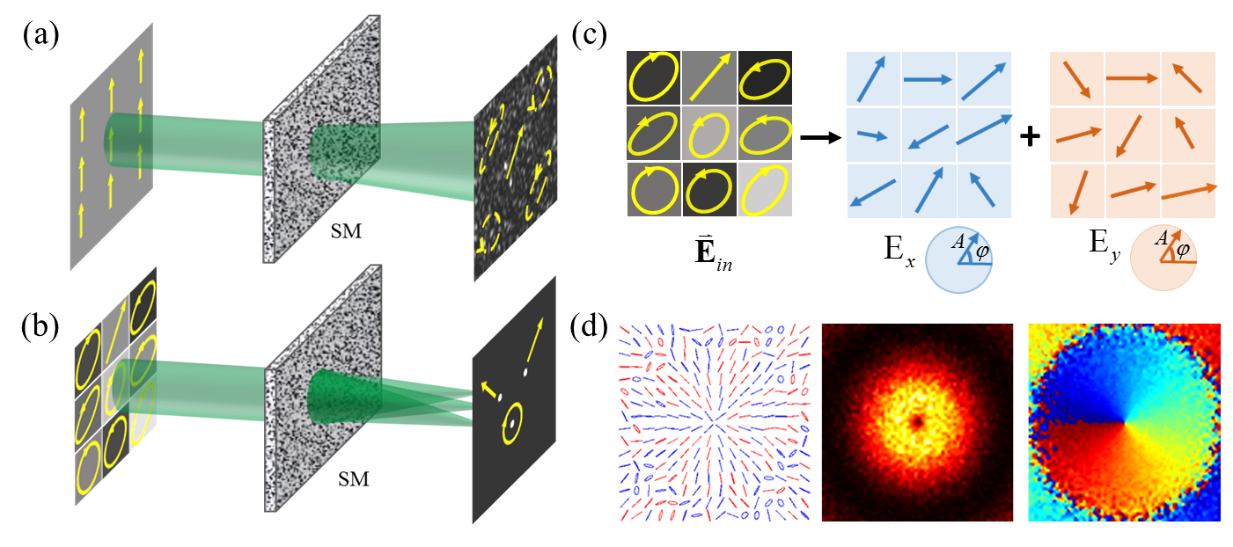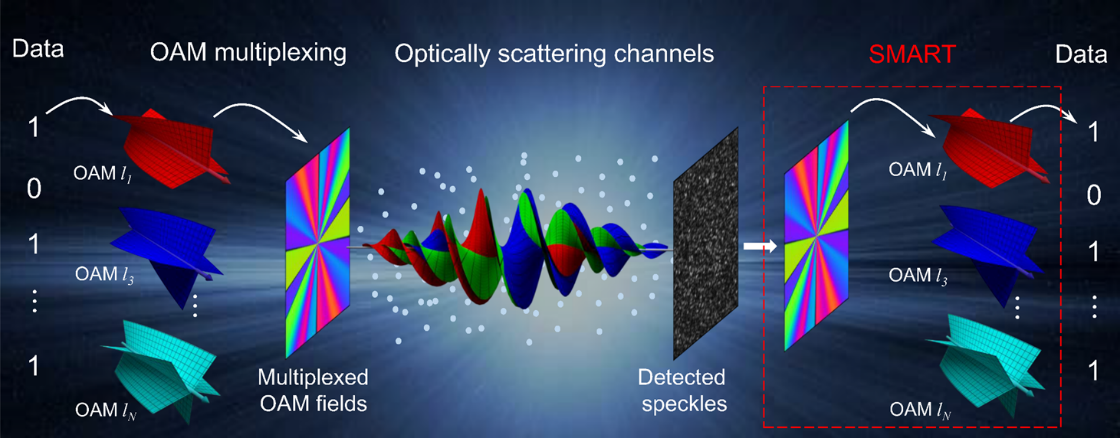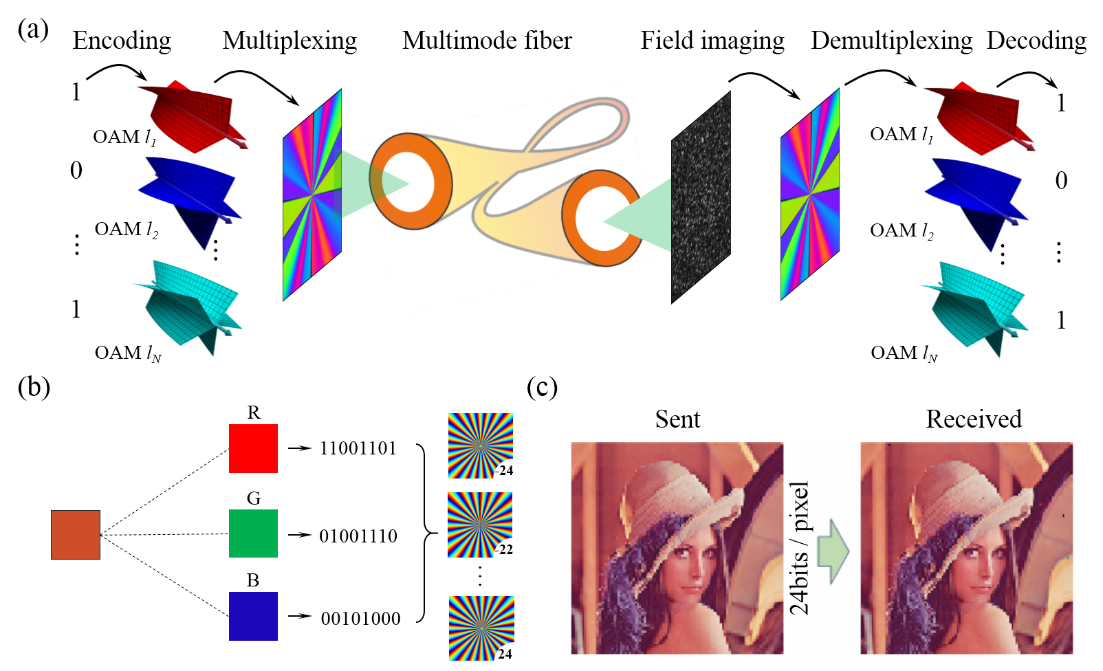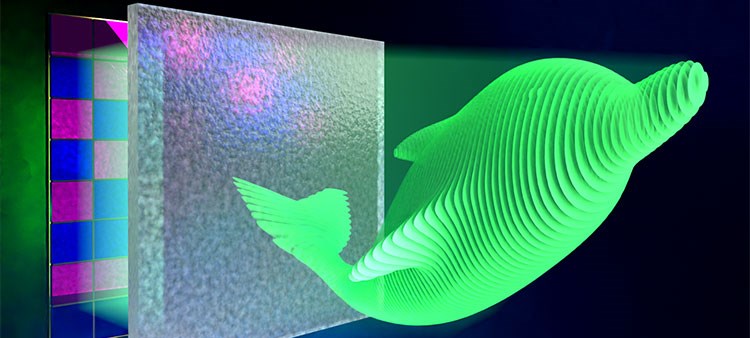Wavefront shaping
The theoretical study on multi-dimensional optical field control through scattering media
Propagation of light through highly scattering media, such as biological tissue, muddy liquid, and disturbed atmosphere, yields speckle patterns. It is well known that both the amplitude, phase and polarization of the incident light are scrambled during the process due to the multiple scattering of light. We present a general framework based on the vector transmission matrix (VTM) to control the multi-dimensional information of optical field. By measuring the VTM of the scattering system and shaping both the amplitudes and phases of two orthogonal polarization components of the input field impinging on the scattering media, one can simultaneously control the amplitude, phase, and polarization of the light (Fig. 1). This model proposes a multi-parameter regulation method of anti-scattering light field in principle [1].

Fig. 1. The principle and simulation results of multi-dimensional optical field control through scattering media [1]
The experimental study on the intensity and polarization control of 2D (3D) light fields through scattering media
We have experimentally developed multiple complex wavefront shaping techniques based on the scattering media, including genetic algorithm, bat algorithm, and transmission matrix method [2-4], which combine the DMD to optimize the wavefront of the incident light for controlling the polarization and intensity distributions of the 2D light field through scattering media. In further, we present an approach to achieve 3D focusing through scattering media, which combines 3D computer-generated holography (CGH) with point spread-function (PSF) based wavefront shaping. As a proof of concept, generating user-specified 2D intensity patterns and 3D focusing through scattering media were demonstrated. Further, axial scanning of the focus was realized digitally by using a digital micromirror device. Experimentally, our method achieves an axial scanning range 20 times larger than that obtained by the memory effect method (Fig. 2) [4]. Our work is expected to benefit long-range optical trapping and volumetric imaging through highly scattering media.

Fig. 2. Multiple focal spots generated at different depths simultaneously through scattering meid [4]
Vectorial holographic display based on optical scattering(Applications of wavefront shaping techniques)
We report a new concept of dynamic vectorial holography with scattering-enabled polarization-insensitive holograms with arbitrary linear-polarization incident light by introducing the optical scattering. The multiple light scattering of the scattering media transforms the incident linear polarization light into volume speckle fields with spatially various polarization states, and all the degrees of freedom of the speckle fields can be converted into a 2D optical wavefront for phase-hologram rendering. By combining the scattering media and DMD, the scattering wavefronter can achieve dynamic polarization display with multiple polarization states by loading a series of scattering-enabled polarization-insensitive holograms, which endows the light control toolbox with an unprecedented capability of simultaneous intensity and polarization. We experimentally demonstrate polarization display with multiple polarization states including non-orthogonal polarization and dynamic polarization display with two orthogonal polarization states, respectively (Fig. 3)[5].

Fig. 3. Experimental demonstration of dynamic vectorial holography for polarization display with two orthogonal polarization states [5]
Optical OAM-multiplexed data transmission under high scattering
The OAM of light has been considered as a promising degree of freedom for multiplexing data in free space and optical fiber systems. However, the propagation of light beams through scattering media or multimode systems yields well-known speckle patterns that arise from the self-interference of multiply scrambled light, which will scramble the wavefronts of the OAM modes and destroy the orthogonality between the OAM channels. Consequently, it is challenging to realize OAM-based communication through scattering media. For this purpose, we propose a scattering-matrix-assisted retrieval technique (SMART) to precisely extract encoded OAM states from multiply scattered light (Fig. 4). Experimentally, we achieve a low crosstalk of –13.8 dB in the parallel sorting of 24 scattered OAM channels and demonstrate high-fidelity transmission of both gray and color images at a low error rate of <0.08%, which is enhanced by ~ 21 times compared with previous reports [6].

Fig. 4. Concept of SMART-enabled OAM-multiplexed transmission across scattering channels [6]
Optical OAM-multiplexed data transmission through multimode fibers
Here, we present a computational light field imaging technique to achieve OAM-multiplexed transmission through a commercial multimode fiber (MMF), which is achieved by exploiting the speckle-correlation scattering matrix [6]. Our technique enables to precisely recover the incident light field (including the amplitude and phase) via a single-shot intensity speckle pattern recorded at the distal end of the fiber. Furthermore, high-fidelity transmission of color image information at an error rate of <0.72% was achieved (Fig. 5). Compared with the previous fiber-optic schemes, our technique employs a computational method to distinguish every OAM channel, avoiding the use of optical OAM coupler and demultiplexer. In addition, light field imaging through MMFs could benefit endoscopes with the ability of phase imaging in biomedical imaging [7].

Fig. 5. The results of OAM-encoded data transfer through a commercial MMF [7]
Ultrahigh-density 3D holographic projection by scattering-assisted dynamic holography
We report 3D scattering-assisted dynamic holography (3D-SDH) that further breaks the depth-control limit of the state-of-the-art method. Our approach achieves orders of magnitude improvement in axial resolution and greatly suppresses crosstalk, enabling ultrahigh-density 3D holographic projection. Moreover, 3D-SDH enables dynamic 3D vectorial projections via phase-only holograms. The concept is validated through both simulations and experiments, where dynamic projections of 3D point-cloud objects onto high-density successive planes are demonstrated. Our work opens perspectives for 3D holographic technology with ultra-fine depth control, dynamic projection, and polarization multiplexing functionalities[8].

Fig. 6. Ultrahigh-density multiplane projection illustration of a dolphin [8]
The study of deep tissue cells in living animals based on wavefront shaping techniques(Under development)
A focused laser beam cannot go deep into the biological tissues due to high scattering, limiting optical trapping depth in tissues for optical tweezers that currently trap cells in the superficial layer of a skin. Therefore, our research group is studying the applications of complex wavefront shaping techniques in optical trapping. Now, we try to achieve optical focusing through the deep tissue in vivo, and then trapping and manipulation the cells in the deep tissue of living zebrafishes.
Reference:
[1] Panpan Yu, Qian Zhao, Hu Xinyao, Yinmei Li and Lei Gong. Tailoring arbitrary polarization states of light through scattering media[J]. Applied Physics Letters, 2018, 113(12): 121102.
[2] Ziqiang Wang, Qian Zhao, Panpan Yu, Jiamiao Yang, Yinmei Li, and Lei Gong. Bat algorithm-enabled binary optimization for scattered light focusing[J]. Applied Physics Express, 2019, 12(10): 102002.
[3] Qian Zhao, Ziqiang Wang, Panpan Yu, Yinmei Li, and Lei Gong. Vector focusing through highly scattering media via binary amplitude modulation[J]. Applied Physics Express, 2019, 12(6): 062002.
[4] Qian Zhao, Ziqiang Wang, Xin-Yao Hu, Panpan Yu, Ruishan Chen, Yinmei Li and Lei Gong. 3D focusing through highly scattering media using PSF modulation. Applied Physics Letters, 2018, 113(19): 191104.
[5] Panpan Yu, Yifan Liu, Yijing Wu, Ziqiang Wang, Yinmei Li and Lei Gong. Dynamic Polarization Holographic Projection Enabled by a Scattering Material-Based Reconfigurable Hologram. ACS Photonics 2022, 9, 11, 3712–3719.
[6] Lei Gong, Qian Zhao, Hao Zhang, Xinyao Hu, Kun Huang, Jiamiao Yang, Yinmei Li. Optical orbital-angular-momentum-multiplexed data transmission under high scattering[J]. Light: Science & Applications, 2019, 8(1): 1-11.
[7] Qian Zhao, Panpan Yu, Yifan Liu, Ziqiang Wang, Yinmei Li, and Lei Gong. Light field imaging through a single multimode fiber for OAM-multiplexed data transmission. Applied Physical Letter, 2020, 116(18): 181101.
[8] Panpan Yu, Yifan Liu, Ziqiang Wang, Jinyang Liang, Xingsi Liu, Yinmei Li, Chengwei Qiu, and Lei Gong. Ultrahigh-density 3D holographic projection by scattering-assisted dynamic holography. Optica. 10, 4, 481-490 (2023).


